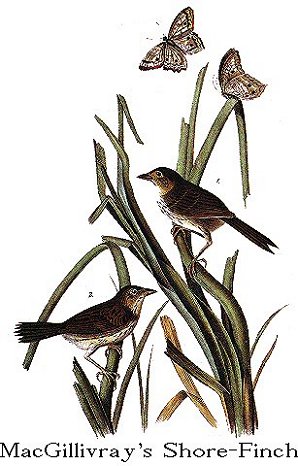
| Family XV. FRINGILLINAE. FINCHES. GENUS V. AMMODRAMUS, Swains. SHORE-FINCH. |
Next >> |

Family |
MACGILLIVRAY'S SHORE-FINCH. [Seaside Sparrow (see also Sea-Side Finch).] |
| Genus | AMMODRAMUS MACGILLIVRAYI, Aud. [Ammodramus maritimus.] |
Whilst BACHMAN's Finch resides in the pine forests of the Carolinas and
other Southern States, preferring dry and sandy lands covered with grasses; and
whilst HENSLOW's Bunting or Finch, and the Yellow-winged Bunting, are fond of
open prairies and ploughed fields, in which they nestle; the species, on which I
have bestowed the name of my friend MACGILLIVRAY, chooses for its residence the
salt marshes of our Southern Atlantic shores, in which also are found the
Sharp-tailed and Sea-side Finches of WILSON and other authors. The three former
spend the greater part of the winter in the forests, perch occasionally on
trees, and feed principally on seeds; whereas the latter three are never found
elsewhere than in the salt marshes, and feed chiefly on minute shells and
aquatic insects.
MACGILLIVRAY's Finch is as yet very rare within the United States, and has
not been observed farther eastward than Sullivan Island, about six miles from
Charleston in South Carolina; but it is very abundant in the Texas, occurring on
all the low islands that are much intersected by salt-water bayous, and
interspersed with ponds of brackish water, seldom leaving these localities
unless whilst travelling, or passing from one island to another, which they do
by flying at the height of only a few feet above the surface. They run among
the rankest weeds with uncommon celerity, and do not seem to mind being followed
by a dog, which they very easily elude amongst the thick grass. Whilst breeding
they often start from a little distance, and pursue a singularly irregular or
zigzag flight, much resembling that of the Jack Snipe of Europe, and yet
performed with apparently slow beats of the wings. They fall as it were among
the grass as suddenly as they rise from it, and by these manoeuvres save their
nests from the searching eye of the keenest student of nature. They very seldom
alight on the stems of grasses, although when they do they climb with facility,
occasionally using their tail as a support, in the same manner as the Rice-bird.
Their strong tarsi and toes enable them to walk on the ground with great vigour.
When they take wing deliberately, their flight resembles that of a young
partridge, and, if over the land, is seldom extended beyond forty or fifty yards
at a time. The males appear very jealous of each other, and frequently one
pursues another on wing, but usually abandons the chase before the conquered
bird has alighted, leaving it to pursue its course as it pleases after it has
been driven beyond the assailant's jurisdiction. The notes of this species are
few and unmusical, consisting of a sort of roll of five or six syllables, which
it seems to me impossible to imitate. They are usually heard early in the
morning. My friend Dr. BACHMAN informs me that none of these Finches remain in
South Carolina during winter, and that they generally disappear early in
November, when the weather is still very pleasant in the maritime portions of
that state. Many, however, spend the winter in the salt marshes about the
mouths of the Mississippi, and I have no doubt that they are constant residents
there, as they are in the Texas.
Abundant in Texas and along the Gulf of Mexico. Rather rare in South
Carolina, from which it migrates in autumn.
MACGILLIVRAY's FINCH, Aud. Orn. Biog., vol. ii. p. 285; vol. iv. p. 394;vol. v. p. 499.
Bill dusky brown above, the sides of the upper mandible paler, the lower
mandible bluish-grey. Iris hazel. Feet dark brown. The colouring is similar
to that of A. maritimus in the upper parts, and to that of A. caudacutus in the
lower, but is darker above than the former, and duller beneath than the latter.
Feathers of the head brownish-black, margined with dull greyish-brown, but not
grey in the middle nor darker towards the sides, as in the other species. Hind
neck and back of the same colour, the middle of the latter having some of the
margins pale reddish-brown. Primary quills hair-brown; secondary dark brown,
edged with reddish-brown; the secondary and smaller coverts like the latter; the
edge of the wing white, slightly tinged with yellow. Tail-feathers hair-brown
at the edges, the centre blackish-brown, except the lateral, which are plain,
but scarcely paler. A yellowish-brown streak from the nostrils over the eye.
Throat and fore neck greyish-white, with an indistinct dusky streak on each
side. Breast and sides pale dull yellowish-brown, marked with brownish-black
streaks. The middle of the breast and the abdomen greyish-white, tinged with
yellowish-brown.
Length 5 1/2 inches, extent of wings 7 3/4; bill along the back (6 1/2)/12,
along the edge 8/12; tarsus 11/12.
| Next >> |